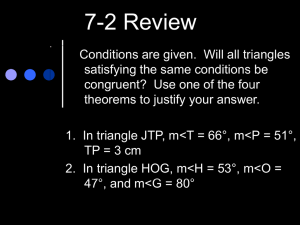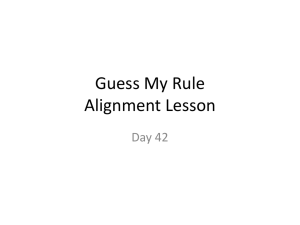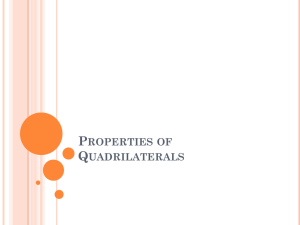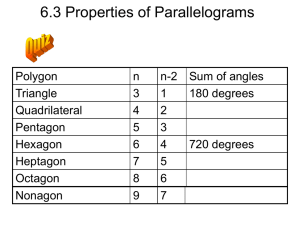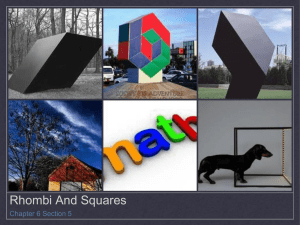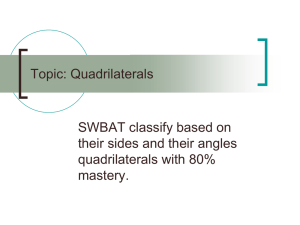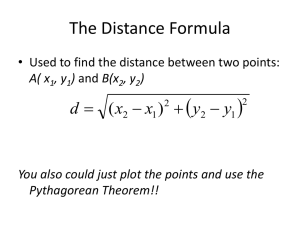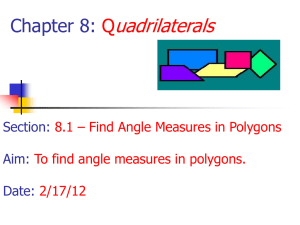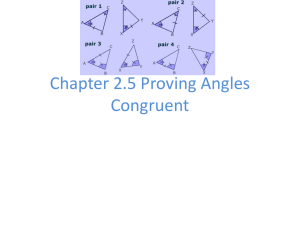Chapter 8 Power Point
advertisement
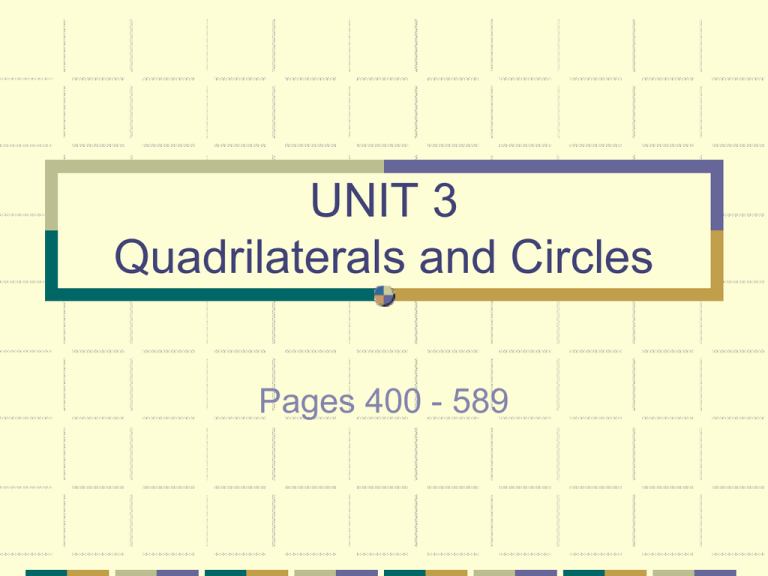
UNIT 3 Quadrilaterals and Circles Pages 400 - 589 Ch.8 Quadrilaterals Pages 402-459 8-1 Angles of Polygons p.404 diagonal - in a polygon, a segment that connects nonconsecutive vertices of the polygon *Review polygons and regular polygons Ch.1-6 (p.45) - know how the chart on page 404 works Theorem 8.1 Interior Angle Sum Theorem If a convex polygon has n sides and S is the sum of the measures of its interior angles, then S = 180(n - 2). Ex.] n=6 S = 180(n - 2) = 180(6 - 2) = 720 Theorem 8.2 Exterior Angle Sum Theorem If a polygon is convex, then the sum of the measures of the exterior angles, one at each vertex, is 360. 2 Ex.] m1 + m2 + m3 + m4 + m5 = 360 1 3 5 4 8-2 Parallelograms p.411 parallelogram - a quadrilateral with parallel opposite sides Any side of a parallelogram may be called a base. Ex.] ABCD A D There are two pairs of parallel sides. AB and DC ; AD and BC B C Properties of Parallelograms Theorem 8.3 Opposite sides of a parallelogram are congruent. Abbreviation: Opp. Sides of * See board for examples and/or p. 412/413 ~. are = Theorem 8.4 Opposite angles in a parallelogram are congruent. Abbreviation: Opp. s of ~. are = Theorem 8.5 Consecutive angles in a parallelogram are supplementary. Abbreviation: Cons. s in are suppl . Theorem 8.6 If a parallelogram has one right angle, it has four right angles. Abbreviation: If has 1 rt. , it has 4 rt. s . Diagonals of Parallelograms Theorem 8.7 The diagonals of a parallelogram bisect each other. Abbreviation: Diag. of bisect each other. Theorem 8.8 Each diagonal of a parallelogram separates the parallelogram into two congruent triangles. 8-3 Tests for Parallelograms * Can be found on p.418 with p.417 Theorem 8.9 examples. Copy next slide instead. If both pairs of opposite sides of a quadrilateral are congruent, then the quadrilateral is a parallelogram. Theorem 8.10 If both pairs of opposite angles of a quadrilateral are congruent, then the quadrilateral is a parallelogram. Theorem 8.11 If the diagonals of a quadrilateral bisect each other, then the quadrilateral is a parallelogram. Theorem 8.12 If one pair of opposite sides of a quadrilateral is both parallel and congruent, then the quadrilateral is a parallelogram. Tests for a Parallelogram 1. Both pairs of opposite sides are parallel. (Definition) 2. Both pairs of opposite sides are congruent. (Thm. 8.9) 3. Both pairs of opposite angles are congruent. (Thm. 8.10) 4. Diagonals bisect each other. (Thm. 8.11) 5. A pair of opposite sides is both parallel and congruent. (Thm. 8.12) If a quadrilateral meets one of the five tests (page 419), it is a parallelogram. All of the properties of parallelograms need not be shown. Parallelograms on the Coordinate Plane When given points on the coordinate plane, we can use the Distance Formula and the Slope Formula and the Midpoint Formula or a combination of the above to determine if the quadrilateral is a parallelogram. * See page 420 for examples. 8-4 Rectangles p.424 rectangle - a parallelogram with four right angles A rectangle is a parallelogram, but a parallelogram is not necessarily a rectangle. Theorem 8.13 If a parallelogram is a rectangle, then the diagonals are congruent. A B D C AC =~ BD Properties of Rectangles 1. Opposite sides are congruent and parallel. 2. Opposite angles are congruent. 3. Consecutive angles are supplementary. 4. Diagonals are congruent and bisect each other. 5. All four angles are right angles. Theorem 8.14 If the diagonals of a parallelogram are congruent, then the parallelogram is a rectangle. * This does not mean that any quadrilateral with congruent diagonals is a rectangle, just parallelograms. 8-5 Rhombi and Squares p.431 rhombus - a parallelogram with all four sides congruent A rhombus is a parallelogram, therefore all of the properties of parallelograms can be applied to rhombi. Theorem 8.15 The diagonals of a rhombus are perpendicular. Theorem 8.16 If the diagonals of a parallelogram are perpendicular, then the parallelogram is a rhombus. (Converse of Theorem 8.15) Theorem 8.17 Each diagonal of a rhombus bisects a pair of opposite angles. Since a rhombus has four congruent sides, one diagonal separates the rhombus into two congruent isosceles triangles. Drawing two diagonals separates the rhombus into four congruent right triangles. square - a parallelogram with four right angles and four congruent sides A square has all of the properties of • a parallelogram • a rectangle and • a rhombus. * A square is a rhombus, but a rhombus is not necessarily a square. Quadrilaterals Parallelograms Rhombi Kites Squares Rectangles Trapezoids Kites p.438 kite - a quadrilateral with exactly two distinct pairs of adjacent congruent sides F In kite EFGH, diagonal FH separates the kite into two congruent triangles. E G Diagonal EG separates the kite into two noncongruent isosceles triangles. H The diagonals intersect at a right angle. 8-6 Trapezoids p.439 trapezoid - a quadrilateral with exactly one pair of parallel sides. The parallel sides of a trapezoid are called bases. The nonparallel sides are called legs. The pairs of angles with their vertices at the endpoints of the same base are called base angles. U U and T are base angles. V and S are base angles. base leg V T leg base S isosceles trapezoid - a trapezoid in which the legs are congruent, both pairs of base angles are congruent, and the diagonals are congruent Theorem 8.18 Both pairs of base angles of an isosceles trapezoid are congruent. Theorem 8.19 The diagonals of an isosceles trapezoid are congruent. If you extend the legs of an isosceles trapezoid until they meet, you will have an isosceles triangle. median - in a trapezoid, the segment that joins the midpoints of the legs median Theorem 8.20 The median of a trapezoid is parallel to the bases, and its measure is one-half the sum of the measures of the bases. (see board for example) Hierarchy of Polygons Polygons Quadrilaterals Parallelograms Rectangles Rhombi Squares Kites Trapezoids Isosceles Trapezoids 8-7 Coordinate Proof with Quadrilaterals p.447


